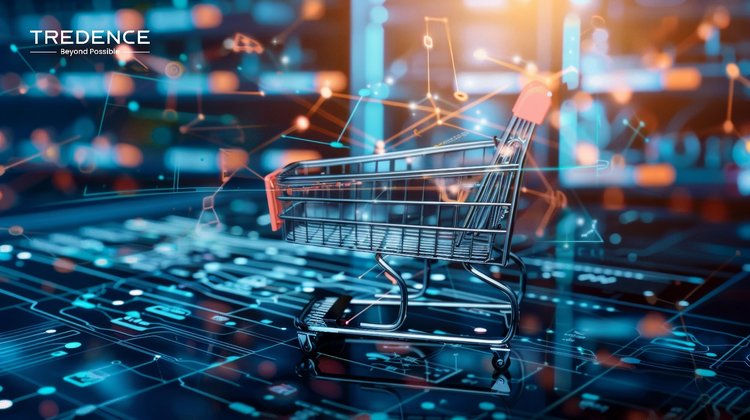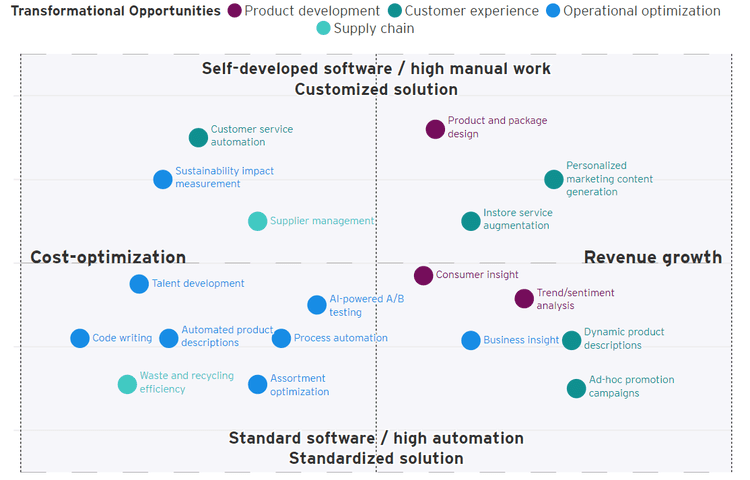Maximizing CPG Value with Zero Risks Using Generative AI
Chewi |Jun 27, 2024
- Major Music Labels Enter Licensing Talks with AI Generators Suno and Udio
- The Showdown: Generative AI vs Adaptive AI - Which is Right for You?
Table of Contents
- Generative AI in CPG: What is the current situation?
- The best Generative AI applications in CPG
- Risks and limitations of Generative AI for CPG companies
- Achieving Zero Risks: Mitigation Strategies for Generative AI
- How could Generative AI add value to the CPG sector?
- The bottom line: Grow CPG value with Generative AI
The buzz around Generative AI doesn't seem to stop, but companies still need to understand the best use cases and address impelling challenges. Learn the risks associated with this technology and be among the first ones to reap GenAI benefits while minimizing the risks.

Generative AI in CPG: What is the current situation?
2023 was the breakthrough year for Generative AI, and its growth will continue in 2024. Leaders around the globe are finding new business use cases for GenAI every other day, while the technology is already affecting how consumers behave.
While initially it was somewhat left behind, with industries like healthcare and tech paving the road for GenAI adoption, the CPG industry quickly catches up while interest in Generative AI keeps growing.
As more and more CPG companies turn to CPG analytics and AI, those who have already implemented it are satisfied with the results and confident for future developments.
40% of CPG leaders are satisfied with how they currently use GenAI and 22% report that they are already reaping the benefits of their business operations. (Source: EY)
With all this enthusiasm comes an imperative to act quickly. 70% of the interviewed leaders believe they must invest now in Generative AI to avoid giving competitors a strategic advantage. However, at the same time, such an investment can be tricky since hidden risks, barriers to entry, and a great degree of knowledge are required. Companies must be aware of the dangers of the situation: brands are now facing a risk-and-reward paradox as they balance business opportunities with governance needs.
In this article, we'll explore the principal risks and limitations of Generative AI in CPG and how to minimize them while maximizing value.
The best Generative AI applications in CPG
While most CPG leaders agree about the transformative power of Generative AI, there is still a certain degree of uncertainty about which use cases are best to invest in. EY has identified the high-impact Generative AI applications in CPG and classified them based on:
- Final economic growth (cost-optimization vs. revenue growth):
- Degree of software automation and customization.

The results show various potential business applications, ranging from human resources to customer service, from market research to product design, and many more. These applications are categorized into four main business areas:
- Product development
- Customer experience
- Operational optimization
- Supply chain management
These are the areas in which currently CPG Generative AI can bring the most benefits, like improving efficiency, reshaping the way workers do their jobs, and streamlining processes. But with these opportunities come risks and challenges that threaten to jeopardize companies' investment in AI.
Risks and limitations of Generative AI for CPG companies
The main risks associated with Generative AI, as theorized by KPMG, can be divided into two categories: those related to the quality of the content generated and the human misuse of Generative AI.
· Intellectual property and copyright infringements.
Generative AI technology uses neural networks trained on large datasets, including personal, sensitive, or confidential data or data protected by intellectual property. Organizations using such tools need to find a way to avoid copyright infringements and protect their own data (for example, avoiding sharing sensitive information).
· Inaccurate results and bias.
There is another risk associated with the generated outcome. It is important to remember that the output quality is only as high as the quality of the input data: if the data used for training the model is biased, the results risk being biased as well. If the content is inaccurate, it could cause any number of failures that could hurt the business or even create liability issues.
· Human misuse
While using Generative AI tools offers excellent opportunities for efficiency, they could also be used for illicit reasons. Deepfakes, artificial images, or actual persons' videos are currently a big issue. For example, a deepfake image could show a company's CEO in a scandalous situation. There are also cybersecurity risks, as Generative AI can create more sophisticated phishing scams to hack into the company's system.
While it is fundamental for businesses to be aware of the risks of any new technology before implementing it, it shouldn't stop adoption. The benefits and opportunities offered by Generative AI and the ever-expanding array of applications are just too good to be ignored. Consider a strategic partnership with a GenAI consulting company like Tredence to develop a robust, risk-free AI strategy.
Achieving Zero Risks: Mitigation Strategies for Generative AI
To successfully integrate and manage new technology, especially one as transformative and powerful as Generative AI, it is fundamental to have in place a clear and consistent governance strategy. Here are some steps to design and implement a governance strategy correctly.
- Build on common principles. Not everything has to be made from scratch: building on case studies and adapting existing principles to your specific situation allows you to act quicker, leverage existing experience, and avoid mistakes.
- Testing and learning allow you to accelerate best practices and build a relevant and robust AI strategy.
- Focus on each different process. How is the AI strategy going to affect each area of the business? Make sure to take your time to answer this question.
- Ensure maximum visibility over where and how Generative AI tools are consistently implemented.
- Review your strategy constantly. Generative AI is evolving rapidly, which means there will be new opportunities to improve efficiency, cost-reduction, scalability, and security and find new use cases. Ensure your AI strategy is flexible enough to be reviewed and upgraded.
How could Generative AI add value to the CPG sector?
According to McKinsey, Generative AI has enormous potential in virtually every industry, including the consumer packaged goods industry.
Executives need to look at GenAI from a value-based perspective, i.e., identifying where the value lies and which sort of value it is (economic, sustainability, or customer experience). Although they can all translate into monetary value in the end, understanding the nature of the benefit is fundamental to establishing meaningful and reachable KPIs.
Another essential point to remember is that you don't need to invest in GenAI for the sake of it. For most cases, you probably need only regular AI. Generative AI can be a significant and risky investment, and you want to maximize the return on that investment, which means applying this technology only when it can bring additional value. Don't invest your money without a proper strategy and awareness of the associated risks.
The bottom line: Grow CPG value with Generative AI
Generative AI is destined to unleash the next wave of productivity. Knowing how to mitigate the risks and where business value will accrue will mean being at the forefront of the GenAI revolution. Excitement over this technology doesn't stop growing, and early adopters are already rushing to be the first ones to reap the benefits.
However, as a society, we still need to figure out how to handle risks and challenges; moreover, only with time will we understand the true impact of Generative AI and its best use cases. If executives find a way to minimize risks, this technology has the potential to contribute substantially to global economic growth. Those ready to adopt this technology now will be in a position of advantage in the future, when Generative AI will be the winning weapon to overcome competition.
- Tag






Comments
Sort by Newest | Popular